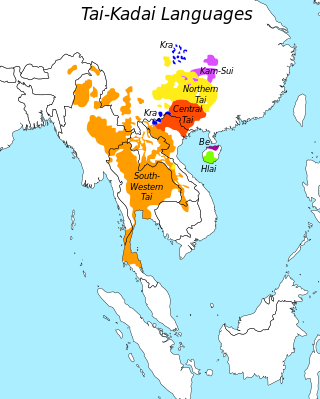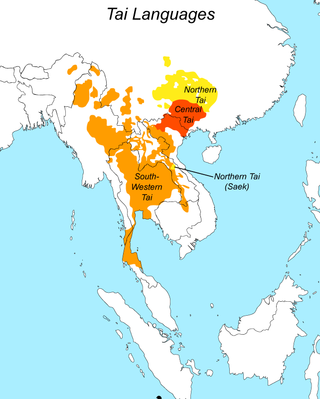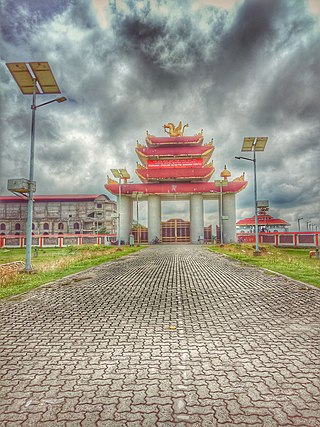
The Kra–Dai languages, are a language family in Mainland Southeast Asia, Southern China and Northeastern India. All languages in the family are tonal, including Thai and Lao, the national languages of Thailand and Laos, respectively. Around 93 million people speak Kra–Dai languages; 60% of those speak Thai. Ethnologue lists 95 languages in the family, with 62 of these being in the Tai branch.

The Shan people, also known as the Tai Long or Tai Yai, are a Tai ethnic group of Southeast Asia. The Shan are the biggest minority of Burma (Myanmar) and primarily live in the Shan State of this country, but also inhabit parts of Mandalay Region, Kachin State, Kayah State, Sagaing Region and Kayin State, and in adjacent regions of China, Laos, Assam and Meghalaya, Cambodia, Vietnam and Thailand. Though no reliable census has been taken in Burma since 1935, the Shan are estimated to number 4–6 million, with CIA Factbook giving an estimate of five million spread throughout Myanmar which is about 10% of the overall Burmese population.

The Ahom script or Tai Ahom Script is an abugida that is used to write the Ahom language, a dormant Tai language undergoing revival spoken by the Ahom people till the late 18th-century, who established the Ahom kingdom and ruled the eastern part of the Brahmaputra valley between the 13th and the 18th centuries. The old Ahom language today survives in the numerous manuscripts written in this script currently in institutional and private possession.

The Tai, Zhuang–Tai, or Daic languages are a branch of the Kra–Dai language family. The Tai languages include the most widely spoken of the Tai–Kadai languages, including Standard Thai or Siamese, the national language of Thailand; Lao or Laotian, the national language of Laos; Myanmar's Shan language; and Zhuang, a major language in the Southwestern China's Guangxi Zhuang Autonomous Region, spoken by the Zhuang people (壯), the largest minority ethnic group in China, with a population of 15.55 million, living mainly in Guangxi, the rest scattered across Yunnan, Guangdong, Guizhou and Hunan provinces.

The Ahom or Tai-Ahom is an ethnic group from the Indian states of Assam and Arunachal Pradesh. The members of this group are admixed descendants of the Tai people who reached the Brahmaputra valley of Assam in 1228 and the local indigenous people who joined them over the course of history. Sukaphaa, the leader of the Tai group and his 9,000 followers established the Ahom kingdom, which controlled much of the Brahmaputra Valley in modern Assam until 1826.

The Ahom language or Tai-Ahom language is a dead language, that was formerly spoken by the Ahom people, but which is currently undergoing a revival. Ahom is an important language in Tai studies. It was relatively free of both Mon-Khmer and Indo-Aryan influences and has a written tradition dating back to the 13th century.

The Shan language is the native language of the Shan people and is mostly spoken in Shan State, Myanmar. It is also spoken in pockets in other parts of Myanmar, in Northern Thailand, in Yunnan, in Laos, in Cambodia, in Vietnam and decreasingly in Assam and Meghalaya. Shan is a member of the Tai–Kadai language family and is related to Thai. It has five tones, which do not correspond exactly to Thai tones, plus a sixth tone used for emphasis. The term Shan is also used for related Northwestern Tai languages, and it is called Tai Yai or Tai Long in other Tai languages. Standard Shan, which is also known as Tachileik Shan, is based on the dialect of the city of Tachileik.
The khamyang, is a subgroup of the Tai peoples of Southeast Asia. They are numerically a small indigenous group found in Tinsukia, Jorhat, Sivasagar and Golaghat districts of Assam, and adjacent parts of Arunachal Pradesh. Their population totals about 7,000, of which only a small minority speak the native Tai Khamyang language while the vast majority speak the Assamese language. The Khamyang are followers of Theravada Buddhism and are closely related to the Khamti. They maintain good relations with other Tai Buddhist tribes of Assam.

The People of Assam inhabit a multi-ethnic, multi-linguistic and multi-religious society. They speak languages that belong to four main language groups: Tibeto-Burman, Indo-Aryan, Tai-Kadai, and Austroasiatic. The large number of ethnic and linguistic groups, the population composition, and the peopling process in the state has led to it being called an "India in miniature".
Khamyang is a critically endangered Tai language of India, spoken by the Khamyang people. Approximately fifty people speak the language; all reside in the village of Powaimukh, located seven miles downstream of Margherita in the Tinsukia district. It is closely related to the other Tai languages in the Assam region: Aiton, Khamti, Phake, and Turung.
The Turung language is an endangered Sino-Tibetan language, closely related to Singpho, spoken in seven villages in central Assam. Many Turung people now speak Assamese.
By the end of the 18th century the people of Tai-Page entreated Assam located in Northeastern India, establishing their kingdom. The word Page is derived from the Tai words 'Pa' meaning wall and 'ge' meaning ancient or old.
The Tai Aiton are one among the six indigenous Tai communities of Assam. They are Animist and Buddhist by religion. They speak the Tai Aiton language, which is similar to other Tai languages spoken in Thailand. They have been recognized as Scheduled Tribes (Hills) and are listed as Man-Tai speaking people by the Government of Assam.

Tai peoples are the populations who speak the Tai languages. There are a total of about 93 million people of Tai ancestry worldwide, with the largest ethnic groups being Dai, Thais, Isan, Tai Yai (Shan), Lao, Tai Ahom, and Northern Thai peoples.

The Southwestern Tai, Thai topolects or Thailanguages are a branch of the Tai languages of Southeast Asia. Its languages include Central Thai (Siamese), Northern Thai (Lanna), Lao, Shan and others.
The Aiton language or Tai Aiton language is spoken in Assam, India, in the Dhonsiri Valley and the south bank of the Brahmaputra. It is currently classified as a threatened language, with fewer than 2,000 speakers worldwide. Its other names include Aitonia and Sham Doaniya.
The Phake language or Tai Phake language is a Tai language spoken in the Buri Dihing Valley of Assam, India. It is closely related to the other Southwestern Tai languages in Assam: Aiton, Khamti, Khamyang, and Turung.
The SEAlang Library is an online library that hosts Southeast Asian linguistic reference materials.
The traditional New Year in many South and Southeast Asian cultures is based on the sun's entry into the constellation Aries. In modern times, it is usually reckoned around 14 April.

The Ahom religion is the ethnic religion of the Ahom people. The Ahom people came into Assam in 1228, led by a Tai prince Sukaphaa, and admixed with the local people. The people who came into Assam included two clans of priests, joined later by a third, who brought with them their own religion, rituals, practices and scriptures. The religion is based on ritual-oriented ancestor worship that required animal sacrifice (Ban-Phi), though there was at least one Buddhism influenced ritual in which sacrifice was forbidden (Phuralung). Ancestor worship and the animistic concept of khwan are two elements it shares with other Tai folk religions. There is no idolatry except for the titular god of the Ahom king and though there is a concept of heaven or a heavenly kingdom, there is no concept of hell. It was the state religion of the Ahom kingdom in the initial period.








